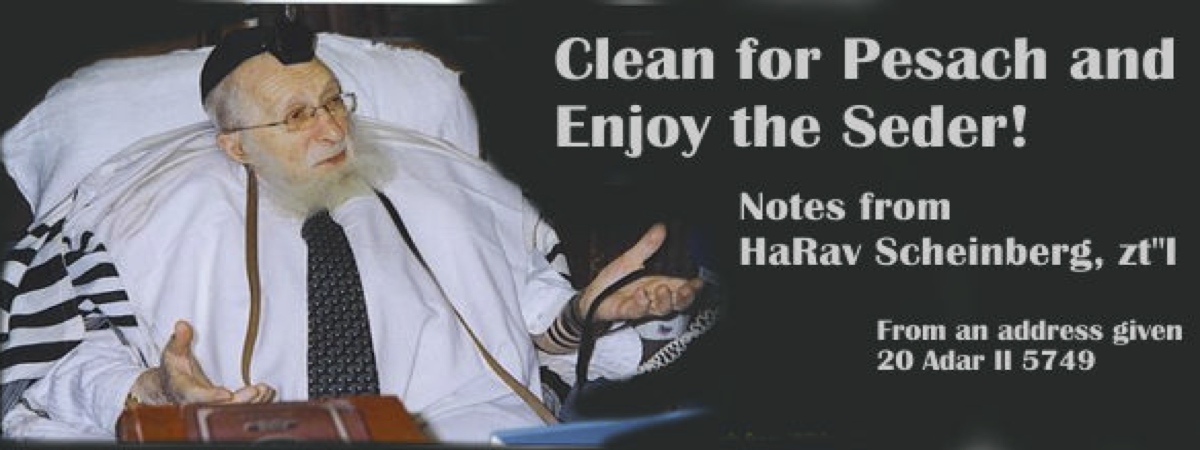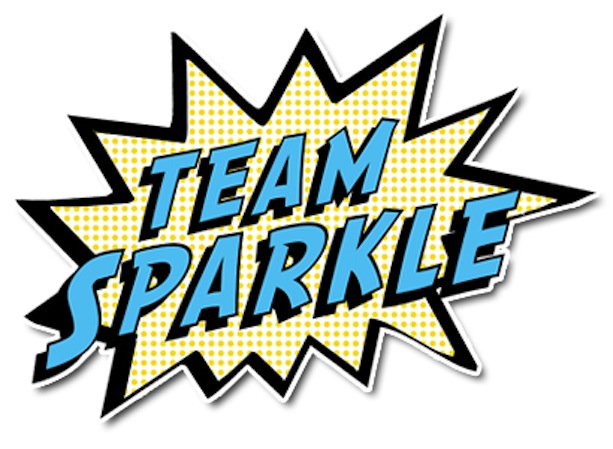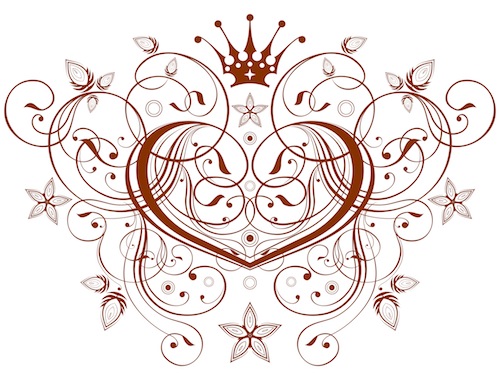|
|
|
Passover Cleaning from HaRav Scheinberg, zt"l
stress less and enjoy the yom tov

This Passover cleaning address was originally delivered 20 Adar II, 5749, source http://www.anshe.org. Based on the responsa of HaRav Chaim P. Scheinberg, shlita, Rosh Yeshiva Torah Ore to questions posed by women attending his regular chizuk talks. Contact Anshe Emes for sources.
Jump to Pesach Cleaning step-by-step
"In former times, wealthy people who had large houses also had many servants who did their every bidding, while poor people, who could not afford servants, lived in small homes with one or two rooms.
Understandably, the Passover cleaning and chores of the rich were performed by the servants, while the poor, who had only their one or two rooms to clean, a few pieces of furniture a minimum of utensils, and some clothing, took care of their needs themselves. In those days, the cleaning was hard. Tables were made of raw wood, requiring them to be scrubbed or even to be shaven to ensure that no pieces of food were hidden in the cracks. Earthen or wooden floors also needed to be thoroughly scrubbed and cleaned.
Today, we seem to be caught in a trap. The average modern home is larger than formerly. Furniture, utensils and clothing are much more plentiful. The average home today could compare with the more affluent homes of previous generations. However, we do not have the servants that they had, so that today, all the Passover cleaning falls on the housewife. At the same time, she still feels obligated to clean and scrub as they did formerly, even though she has laminated furniture and tiled floors, making this type of cleaning unnecessary.
As a result of this, the pressure of Passover cleaning has reached unnecessary and overwhelming levels. The housewife often becomes a nervous wreck, unable to enjoy the Simchas Yom Tov of Pesach and unable to perform the mitzvos and obligations of the Seder night.
Every woman must enjoy Pesach. This is an obligation clearly defined in the Torah as explained by Chazal. She must look forward to it and not dread it like a Tisha B'Av. Every woman and follow the Hagadah with the rest of the family. Clearly, the performance of her Passover cleaning and cooking must be balanced against her Pesach obligations.
Pre-Pesach cleaning is required to avoid the danger of transgressing any Torah or Rabbinic prohibition of having chometz in the house on Pesach. It is evident from the responsa of the Rosh HaYeshiva, shlita, that cleaning need not be excessive.
 |
How to Clean for Passover from Rav Scheinberg, zt'l |
A. All property and possessions must be cleaned and checked to make sure that they are free of all chometz, except in the following cases:
B. If,during the year, chometz is not brought into a place,[then] that place does not have to be cleaned out or checked for chometz.
C. Any article which is not used on Pesach [and] which is closed up and sold, need not be checked for chometz.
D. Crumbs which have been rendered inedible by being completely soaked in a foul-tasting liquid, such as detergent (detergent is defined as a substance with spoils the chometz and renders it inedible.), bleach or ammonia, are not considered chometz, because they are not fit to be eaten by an animal. The general obligation to check for and destroy crumbs does not apply if the crumbs are less than the size of an olive (kezayis) and are dirty enough to prevent a person from eating them.
Pesach Cleaning step-by-step
1. FLOORS: In our times we don't have earthen floors with deep cracks in them. It is sufficient for tiled or covered floors to be swept and rinsed well with a detergent. The small cracks do not have to be checked if the detergent reaches into them.
2. FOOD CABINETS: (If the cabinet is not going to be used on Pesach, see General Notes C & B above.) If the cabinet is going to be used on Pesach, take out all the food and wash it around with a rag soaked in detergent. Be sure the detergent goes into all the cracks and soaks into any crumbs that might be there. However, afterwards, the cabinets are usually lined.
3. REFRIGERATOR: Take the food out, and wipe with a rag soaked in a detergent. Some people cover the racks.
4. CLOTHING CLOSETS: If there is some significant possibility that chometz went into them, they should be checked for fully edible crumbs of chometz, besides regular, large edible chometz foods. If the probability that chometz entered these places is remote, a Rav can be consulted to clarify' the conditions under which they do not have to be checked. This includes chests, dressers, basements, and all other similar cases. (See also General Note B.)
5. KASHERING SINKS: Clean the sinks, and pour a kettle of boiling water into them and on their sides. Some people pour hot water mixed with bleach down the drain. The usual practice today is to line the sinks (e.g., tin foil, contact paper) or to use an insert. If [this is] not difficult, this should be followed.
6. TABLETOPS: Wash them with a detergent. However, afterwards, they are usually covered.
7. MARBLE COUNTERS: If they were used for hot chometz, they should be cleaned well and boiling hot water poured on them, or completely covered so that nothing Pesach'dik touches them. Some people do both.
8. FAUCETS (TAPS): Cleaning, without any other kashering procedure, is sufficient.
9. KASHERING RANGE/OVEN/STOVE TOP:Wipe [the stove top] with a rag soaked in detergent and cover it with tin foil if you wish. Old grates can be kashered by lighting all the burners, raising them to their maximum heat, and putting on a blech while the burners are on. This spreads the heat over the whole top and intensifies the heat on the grates. Let it burn for 5-10 minutes.OVEN: a) Wipe it with a rag soaked in detergent which spoils any particle of edible chometz. If you suspect that there are crumbs or particles of chometz left over which are inaccessible, then clean the oven with any of the regular oven-cleaners (e.g. Easy-Off). Then heat the inside of the oven by turning the oven on to its highest temperature for about one hour. (On electric ovens it should be determined whether the highest temperature is on roasting or broil [or] grill.) However, if a closed oven insert for baking and roasting were available, this would be preferable. In this case, only wiping and cleaning are necessary. b) Do not use the chometz'dik oven racks for Pesach. If this is too difficult, then one can kasher the racks with the same procedure as for the oven.
c) Chometz'dik baking and roasting pans should not be used for Pesach.
10. FOOD PROCESSOR/MIXER: A Rav should be consulted.
11. POTS, PANS, DISHES & SILVERWARE (CUTLERY): Whatever is not going to be used for Pesach should be put away and locked up. If there is actual chometz, it should also be sold. If you do not sell chometz, wash or soak them in a detergent [before putting away], it is not necessary to shine them.
12. DISH TOWELS: If one does not have a Pesach'dik set of dish towels, then one's regular dishtowels may be used if they are washed with a detergent.
13. PESACH TABLECLOTHS: These can be ironed with the same iron as is used during the rest of the year.
14. CLOTHES, BLANKETS, ETC: If they have been washed in a detergent, then there is no need to worry, even if you find crumbs in them on Pesach. Pockets of clothes not being washed or dry-cleaned need only to be checked for chometz by brushing them out. However, if there is a possibility of crumbs between the stitches or in a hidden crevice that cannot be shaken out, then the pockets must be wiped with a wet rag soaked in detergent. Of course, clothes that will not be worn on Pesach can be put away without being checked if all the actual chometz in them is sold.
15. SIDDURIM, BENCHERS, SEFORIM & BOOKS: If there is a chance that they contain chometz crumbs, then they should either be put away with other chometz utensils, or cleaned and checked well.
16. TOYS: If there is edible chometz, then it should be removed; if it cannot be removed, it should be made inedible (see General Notes D & B.) There is no need to scrub them.
17. TECHINA & OTHER KITNIYUS: May be used after the house has been cleaned for Pesach. They should not be cooked in utensils that will be used on Pesach, and certainly not on Pesach itself (according to Minhag Ashkenaz).
18. CHECKING THE ROOMS: If it is too difficult to check all the rooms on one night, then the work may be divided and done, according to the Laws of Bedikas Chometz, at other times. No chometz should be left in any room that has been cleaned and checked properly. The brocho may never be recited before the night of the 14th. Therefore, at least one place where chometz was left should be left unchecked in order to fulfill the mitzvah of Bedikas Chometz on that night. But if the whole house has been cleaned completely, then somebody else should hide 10 pieces of chometz (according to the Minhag) so that a proper bedikah is made.
19. FOOD THAT FALLS: onto a chair or onto the floor on Pesach should be washed off for hygienic reasons. The food does not become chometz even if the food is hot.
20. LAST MINUTE PREPARATIONS: For example, setting the table, making the beds, etc., should be completed early enough in the day so that you will be able to rest a little bit. Be ready to start the Seder immediately after Maariv to ensure that the children won't fall asleep at the Seder.
21. ENJOY PESACH! Try to make the Passover cleaning and cooking easy for yourself Don't do unnecessary hard work. Don't do unnecessary cleaning. You can be like a Queen and you must enjoy your Pesach!
Share This With Your Loyal & Royal Friends (They'll Thank You!!)

Seder Advice from Rabbi Scheinberg to Jewish Women
Some women have a habit of taking a bite of matzoh, then running back and forth to the kitchen, taking a few more bites in between. In this way, it takes them too long to eat the matzoh, and they do not fulfill the mitzvah properly. The same is true about the wine, maror, korech and afikomen. Therefore, do not leave the table until you have finished eating the required amount. Sit like a Queen!
Relax and be calm while eating and drinking the matzoh and wine within the time limit. The cooking can be checked after completing the mitzvahs. Remember... these are mitzvohs that can be done only once a year, so enjoy them and enjoy the whole Seder. "
KOSHER FOR PASSOVER RECIPES AND MENUS:
Request your free Queen in the Kitchen 3-day Cooking Guide here...
It is not the intention here to abolish Minhagim which have been passed down by Klal Yisroel from generation to generation. Nevertheless, some practices adopted by women in the Pesach cleaning today are not an actual continuation of the old Minhagim. For example, if a person does not sell his chometz, of course it is necessary to check his utensils and to wash off any chometz left on them, or render the chometz inedible. But if the chometz is sold, then scrubbing the pots, pans and dishes which are going to be locked away is not necessary. One might be tempted to insist on doing the extra work anyway -- to be machmir (stringent). However, in stringencies lie the grave danger of causing many laxities and brushing aside many mitzvohs completely -- the Torah and Rabbinic obligations which women are required to do on Pesach and particularly during the Seder.
Many people like to do more “cleaning” than the bare minimum to such an extent that some even incorporate their general “spring cleaning” into their required pre-Pesach chores. These extra exertions should not prevent her from fulfilling her obligations on Pesach, and particularly on the Seder night.
While knowing what is necessary to clean and focusing on that is of primary importance to keep us emotionally balanced, Rav Yitzchok Berkovits says this urge for extra cleaning actually has a positive source and he shares the secret with us—>


